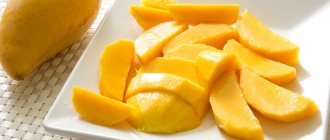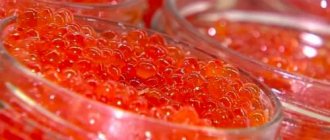Mangoes can be found quite often on store shelves, as the exotic fruit has become very popular in our country. It is loved because of its sweet, juicy taste, but due to its increased sweetness, mango is a perishable product. How to store fruit correctly at home so that it does not spoil or lose its sweetness, simple tips and time-tested storage methods will help.
General recommendations
Mango is an exotic and beloved fruit by many, which is brought to us from warm countries, which is why it often does not have time to ripen and is sold green in stores. This is the main difficulty of storing it, which is why many are faced with the fact that it begins to deteriorate within a few days after purchase.
When storing fruit, follow the rules and tips:
- Average temperature. Regardless of the variety and degree of ripeness of mango, it is recommended to store it at a temperature of +8 to +16 degrees Celsius. Then all useful elements will be preserved in it, and it will not deteriorate.
- Not too high humidity. High air humidity can lead to rotting of the fruit, so this indicator should remain within 80-90%.
- No sudden temperature changes. The temperature in the place where the treats are stored must be stable.
- Avoid plastic bags and cling film. If you want to fold or wrap the fruit in something, use parchment paper or paper bags for this - they will preserve the freshness and benefits of the fruit.
Mangoes must be handled carefully - do not throw, crush or roll the fruit. The appearance of dents on an unripe fruit can lead to its premature spoilage and rotting.
How to choose
- You can determine the normal degree of ripeness of a mango by its aroma and sweet taste. The fruit should be round in shape with a smooth, elastic skin. If you gently press on the peel and release, it immediately returns to its original shape.
- It is better to buy fruits that are purchased for storage purposes slightly unripe. You can easily recognize them: they are harder and have a weak aroma.
- Regardless of whether the fruit is ripe or not, there should be no dark brown or gray spots on its surface, as well as dents or damage. The fruit pulp should have a uniform color corresponding to the degree of ripeness.
Storing unripe mangoes
Most often, the final ripening of mangoes at home occurs in 3-5 days, which depends on its initial condition.
When storing unripe mangoes, follow these tips:
- Do not store the fruit in the refrigerator. At low temperatures, the fruit will not be able to ripen and will gradually begin to deteriorate.
- Place the fruit in a paper bag or wrap it in parchment paper.
- Store the fruit in a warm, bright place. For example, you can simply leave it on the countertop for a couple of days or even put it on the windowsill - the sun's rays will speed up the ripening of the fruit.
- To speed up its ripening, add other fruits to it - bananas, apples, pears.
You can tell that a mango is ripe enough by touch. To do this, periodically check it for softness - as soon as, after pressing your finger on the peel, a small dent remains on it, the fruit can be considered ready to eat.
Once the fruit has ripened, it cannot be stored in a warm place. Place it in the refrigerator to avoid spoilage.
Tips for choosing
Before buying a mango in the supermarket, take the fruit in your hand and examine it carefully. Never buy the first fruit you come across or products on sale: there is a chance of running into a “delay.” Ripe fruit can always be distinguished by obvious signs:
- it has a pleasant subtle aroma emanating from the skin;
- When you press your fingers on the pulp, you feel elasticity. The fingers should not fall inside, but the flesh should not be hard;
- There should be no damage or cracks on the skin. The skin is uniform and smooth.
Many people mistakenly believe that a ripe mango should only have an orange color. This is not entirely true. The fruit can be yellow, green, red in color - its color depends on the variety.
On the shelves of Russian stores there are most often mangoes brought from India, China and Thailand.
Storing ripe mango
If the mango is already ripe, but you don’t want to eat it or use it for cooking, pay attention to its proper storage, which will help keep the fruit juicy and fresh longer.
There is no need to wash the fruit - this way it will be stored longer. Place the fruit in a paper bag or wrap it several times in parchment paper, and then put it on the bottom shelf of the refrigerator closer to the freezer - a lower temperature will increase shelf life. It is not recommended to leave fruit in the refrigerator door, since there it can begin to deteriorate faster due to unstable temperature conditions.
Make sure that there are no other strong-smelling foods near the mango (such as smoked fish) that it might pick up.
Check the fruit daily for softness so that it does not become too soft and crumbly, since overripe fruit can spoil in just a couple of days. Otherwise, you can store it in the refrigerator for up to 8-10 days.
We also invite you to watch a video that explains how to store mangoes:
How to store mangoes at home
If you have a basket of Thai fruits, you can keep them fresh and in prepared form. The product is processed in different ways:
- drying;
- freezing;
- jams and sauces.
How long fresh mango can be stored at home depends on the temperature. Ripe ones live for about 3 days in room conditions, 5-7 in the refrigerator. The shelf life of unripe fruits is up to two weeks.
An oven or electric dryer is used to dry the slices. No special conditions are required for storing dried mango. Like other dried fruits, it likes to be dark and dry. Ambient temperature does not matter.
Cold canning methods require a more detailed analysis and will be described separately.
How to choose ripe fruits
Mangoes are no longer an unattainable dream; they can be bought in any supermarket. But the quality sometimes leaves much to be desired. It's a shame that delicious ripe fruits and hopelessly green and spoiled fruits cost the same. You need to learn how to choose and properly store ripe mangoes at home.
Green and ripe mango fruits
Color Judging ripeness by color is the most common mistake. Depending on the variety, ripe fruits are red, yellow, straw and green.
Consistency To select a ripe fruit, you need to touch it. Unripe, like a plum or peach, is firm and springy. Ripe – soft and pliable.
Aroma: Ripe mango smells fragrant, this smell cannot be confused with anything else. Fruits with greens have almost a subtle aroma.
Defects Quality fruits have a clean skin, without spots or dents. Darkened flesh should not be visible through the skin - this is a sign of spoilage.
If you choose dried or dried mango, check the ingredients. There is nothing unnecessary in a natural product: sugar, syrup, acid and preservatives. Organic dried fruits are delicious on their own, without any additives.
Storage at room temperature
In the warm microclimate of an apartment (t > +18°C), ripe fruits are stored for only a couple of days, and then they begin to quickly deteriorate, just like melons in storage. They should be put in the refrigerator, which will slow down the enzymatic processes. Low temperatures extend the life of mangoes, persimmons and other fruits.
If it is not possible to refrigerate a ripe mango, use a secret trick. Brush the skin with oil and let it soak in. The fruit will stop breathing, metabolic processes will slow down, and ripening will stop. This will help keep supplies warm for a couple of days.
At home, storing mangoes in the room is allowed only if they are not ripe.
Storing Mangoes at Room Temperature and Drying the Pulp
In a refrigerator
Mangoes for direct deliveries from Thailand are removed from the tree at the beginning of ripening and delivered to Russia in portable refrigerated chests. Before sale, they are moved to a warm place for maturation, which lasts 2-3 days.
In chain stores, fruits are kept at low temperatures for weeks. After sale, they do not ripen and quickly deteriorate.
If you are sure that the mangoes did not sit for long before being sold and came to you directly from the plane, then they will be stored in the refrigerator for more than a week. Products of this quality can be purchased from small suppliers who organize delivery channels directly from exotic countries. In large chains, selling from the airplane ramp is not possible.
Can mangoes be stored in the refrigerator? Temperatures below +10°C are used when ripe fruits need to be preserved longer. The shelf life of mangoes in the refrigerator is up to 7 days, which is comparable to storing cheese at home. Keep them on the middle shelf of the chamber at +3...+5°С.
Use parchment or a paper bag as packaging material. When stored in a plastic bag, condensation will form. High humidity is destructive - rot and mold appear.
In the freezer
Before freezing mangoes, they must be chopped or pureed. They are not frozen whole. Choose a harvesting method after first thinking through where and how they will be used.
There are two popular options for preparing for freezing:
Slicing Chop the pulp without skin into small cubes. Cover the board or plate with a bag and place the pieces in one layer. Freeze, place in a container and store for up to 90 days.
Puree Grind the fruit pulp with a blender. Bring the mixture to a boil and immediately remove from heat. This will stop fermentation and allow you to store mango puree in the freezer for up to 6 months.
After thawing, the cubes keep their shape. The taste and aroma do not change significantly when frozen.
For portion packing of preparations for the freezer, use thick bags or rectangular containers. The storage temperature should be as low as possible, preferably below -18°C.
Storing cut mango
It is more difficult to store cut mangoes, since pathogenic microflora quickly accumulates on the cut surface, which can lead to spoilage of the fruit.
Please note that if a mango is left at room temperature, it will begin to rot within a few hours, so it should be placed in the refrigerator immediately.
When storing cut fruit in the refrigerator, follow these rules:
- Place it in a container with an airtight lid - this will help prevent other odors from the refrigerator from penetrating into the mango. However, it is still worth making sure that there is no smoked fish.
- If you did not cut the fruit, but only cut it in half, leave the stone in part and store the rest of the product with it. This will help keep it fresh and juicy longer.
- It is recommended to place the container with fruit in the vegetable compartment or on the top shelf of the refrigerator so as not to overcool it. The refrigerator door should also not be used.
- Brush or sprinkle the cut fruit with lemon juice to prevent it from turning black and maintain its original appearance.
Mangoes also don't last long in the refrigerator - only about a day, so you shouldn't cut too large fruits if you know you won't have time to eat them.
What is the best way to store it?
To store mangoes, it is recommended to use any containers with hermetically sealed lids, since the aromatic fruit quickly spreads its smell throughout the refrigerator and absorbs surrounding odors.
Often, glass, enamel or plastic containers are used to store the fruit. The main thing is to wash them first and dry them thoroughly, since excess moisture can lead to rotting of the fruit.
Is it possible to store cut fruit?
When cut, mango fruits begin to darken quickly, so to successfully preserve them you should follow a few simple steps:
- Sprinkle the fruit pieces generously with freshly squeezed lemon juice.
- Wrap in plastic wrap.
- Place on the middle shelf of the refrigerator.
Cut fruits can be stored for one day at a temperature of +3 to +5 degrees.
Freezing
If you managed to buy a lot of mangoes or you couldn't finish the already ripe fruits, you can resort to freezing them. This method will help preserve the integrity and aroma of the delicacy, but during long-term freezing there will be practically nothing left of the beneficial elements.
Here's how to freeze mangoes:
- Wash the fruit, cut in half and separate the pulp from the kernel.
- Cut the fruit into cubes, slices or other pieces that will be convenient for you to use in the future.
- Transfer the mango to a board lined with a plastic bag, and cover the pieces with another bag or parchment paper on top. Place the board in the freezer.
- After a day, remove the frozen product, package it in bags or plastic containers with a hermetically sealed lid and put it back in the freezer.
You can replace cellophane bags or plastic containers with vacuum bags, in which the fruit will also retain its taste and aroma.
It is recommended to place frozen mangoes in the compartment with vegetables, berries and fruits, in which other strong-smelling products are not stored.
Another option for storing mangoes in the freezer is in the form of a smoothie or puree. To do this, chop and beat the pulp in a blender, and then transfer it to plastic containers and put it in the freezer. This way the fruit will also retain its rich taste and aroma. To defrost puree, simply remove the container with it from the freezer and wait a few hours.
Mangoes are usually stored in the freezer for up to 3 months, after which they are frozen and are not recommended for consumption.
Other ways to store mangoes
Since the freezing method is not suitable for everyone, and the fruit only lasts 7-10 days in the refrigerator, you can resort to one of the following methods for long-term mango storage:
Making confiture or jam from it
Fruit preservation
Drying
Making marmalade or marshmallows
Such methods of preparing various mango preparations will not preserve the benefits of the product, but will help preserve the rich smell and taste of the fruit, which is indistinguishable from store-bought alternatives.
You should resort to such options only if you do not know how to preserve already ripe mango, since it is better to eat it fresh.
The mango has started to spoil
To eat or not to eat?
If your tropical guest is a little overripe, then there is nothing to worry about. It can be prepared by thermal processing. But eating such fruits fresh is no longer worth it; your health is more important than unjustified risks. It is also worth distinguishing between the concepts of ripeness and spoilage. If the mango has become soft and matte, it is not necessarily spoiled, it is simply “ready”. But if there are large black spots on it, a putrid smell, and it literally falls apart in your hands, then you should abandon such a dessert completely.
Mango + alcohol = trouble
Eating mango with alcohol leads to severe stomach upset. This is due to the fact that the acids contained in mangoes irritate the gastric mucosa, and together with alcohol cause nausea and diarrhea. Therefore, never mix these two products, no matter how exotic you want.
Mango smoothie
If your mango is a little wilted, then you can give it a second life and treat yourself to a wonderful smoothie.
Prepare the vitamin mixture as follows:
- Cut off the skin and remove the pit, cut the pulp into slices
- Beat the mango with water in a blender.
- Add yogurt with lemon juice and beat again.
- Pour the drink into glasses and serve.
This smoothie will perfectly replace a snack or morning meal, and will also prevent you from throwing the royal mango into the trash.
Storage errors
Premature spoilage of mangoes is associated with the following storage errors:
- Storing ripe mangoes with other fruits. They secrete special enzymes that can only accelerate ripening and reduce the shelf life of the fruit.
- Storing unripe mangoes in the refrigerator. By stopping the ripening process, you will not increase the shelf life of the fruit. This way it will spoil without even reaching a mature state.
- Storage in a plastic bag. Replace it with parchment paper to prevent the fruit from rotting.
- Storing pitted. If possible, leave the kernel in the fruit so it will last longer.
By following all the rules and recommendations for mango storage, you can not only avoid its premature spoilage, but also preserve all the valuable properties present in the fruit.
Optimal storage conditions
When storing fresh mangoes, it is necessary to maintain the correct humidity and temperature conditions, as well as provide adequate lighting. Compliance with the conditions guarantees the preservation of all the valuable properties of the exotic fruit for a month.
See also
How much and where can sauerkraut be stored and how to choose the best place
Temperature
The optimal air temperature for unripe mango fruits is +13 °C, and for completely ripe ones it should not exceed +10 °C.
Illumination
Bright light is detrimental to mango fruits, so they must be stored in a securely protected place.
Answers to popular questions
How do you know when a mango is ripe?
The ripeness of a mango is usually checked tactilely - to do this, you need to press on its skin and see if there is a dent left on it from your finger that will not recover. If it does appear, the mango is fully ripe.
Does it need to be washed before storing?
If you want your mango to last as long as possible, don't wash or cut it.
What to do if the mango has darkened?
Darkening of the pulp is its normal reaction to contact with oxygen, as a result of which the fruit begins to oxidize. This does not spoil the taste of the fruit, but only affects the appearance. To avoid such darkening, you can lubricate the cut with lemon juice before storing.
How long do unripe mangoes last?
At room temperature, mangoes ripen within 3-5 days, and then they can be stored for several more days. In the refrigerator, this time can double.
Can ripe mangoes be stored at room temperature?
No, it is better to store it in the refrigerator, otherwise it will begin to deteriorate within a day after such storage.
Meet mango! Its beneficial properties and characteristic features
To feel cheerful, energetic and resolutely resist any infections, it is necessary to constantly replenish the reserves of microelements and vitamins in our body. While we understand the benefits of “native” vegetables and fruits, we only know about overseas ones that they have an “unusual taste.” So, let’s get to know each other better: the sunny guest of our table – healthy mango!
Who especially benefits from mango?
| Those who are losing weight can easily afford a mango fruit as a snack. It contains only 68 kcal per 100 grams of pulp. If you don't eat tons of mangoes, they won't harm your diet. |
| In any stressful situation... eat mango! Mango can quickly relieve nervous tension, easily improve your mood, and help overcome stress. |
| Do you often get sick and any infection “sticks” to you? Strengthen your immune system with the help of our overseas friend mango. B vitamins and vitamin C in combination with carotene contribute to a serious strengthening of the immune system. |
| Is your blood pressure going up? We include mangoes in our diet to normalize blood pressure. |
| If you want to preserve beauty and youth for a long time, treat yourself to mangoes more often. This sunny fruit slows down the signs of aging. |
How to store mangoes
- Store ripe mango at a temperature of +15°C -+25°C - then the freshness and beneficial qualities will remain for 2 - 3 days.
- Unripe mangoes are best stored at room temperature for ripening. Each fruit must be wrapped in paper. To speed up ripening, place the mango in the sun. Thus, the mango will “ripen” in 2-3 days. Storing next to apples or bananas will further speed up the ripening process.
- Green mango is not stored in the refrigerator - it may become softer, but will lose its beneficial and tasteful qualities.
- Do you want the mango to sit longer and retain its properties for several weeks? Place the fruits, wrapped in paper napkins, in a cool, dark place (not higher than +5°C).
- The cut fruit should be sprinkled with lemon juice to extend its shelf life. On the middle shelf of the refrigerator, covered with film, it will retain its properties and taste for 1 day.
Cooking with mango
Like many other members of the fruit family, mangoes taste great without any additional preparation. It looks beautiful, smells delicious, is easy to cut – the perfect fruit.
But if you want something like that, feel free to embark on a culinary voyage. Mango goes perfectly not only with other fruits, but also with seafood, rice, dairy and fermented milk drinks.
| Mango chutney from Arkady Novikov's Culinary School Spicy-sweet mango chutney is good both warm and cold! This original Indian sauce is suitable for meat, chicken or duck dishes. View recipe | |
| Yogurt Cheesecake with Honey and Mango Ricotta and yogurt cheesecake is a surprisingly light and creamy dessert with a melt-in-your-mouth texture, crispy crust and fresh mango petals. View recipe | |
| Dessert “Pavlova” with mango cream Light airy meringue, creamy cream made from Mascarpone cheese and tropical mango - this dessert is hard to resist! View recipe | |
| Passion fruit-mango tartlet from the Culinary School of Arkady Novikov. A crumbly sandy base, piquant mango and passion fruit cream, airy meringues like clouds - how can you resist such a dessert? View recipe |











